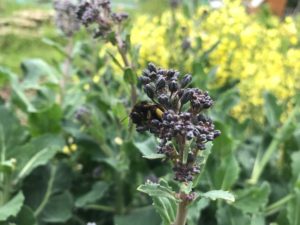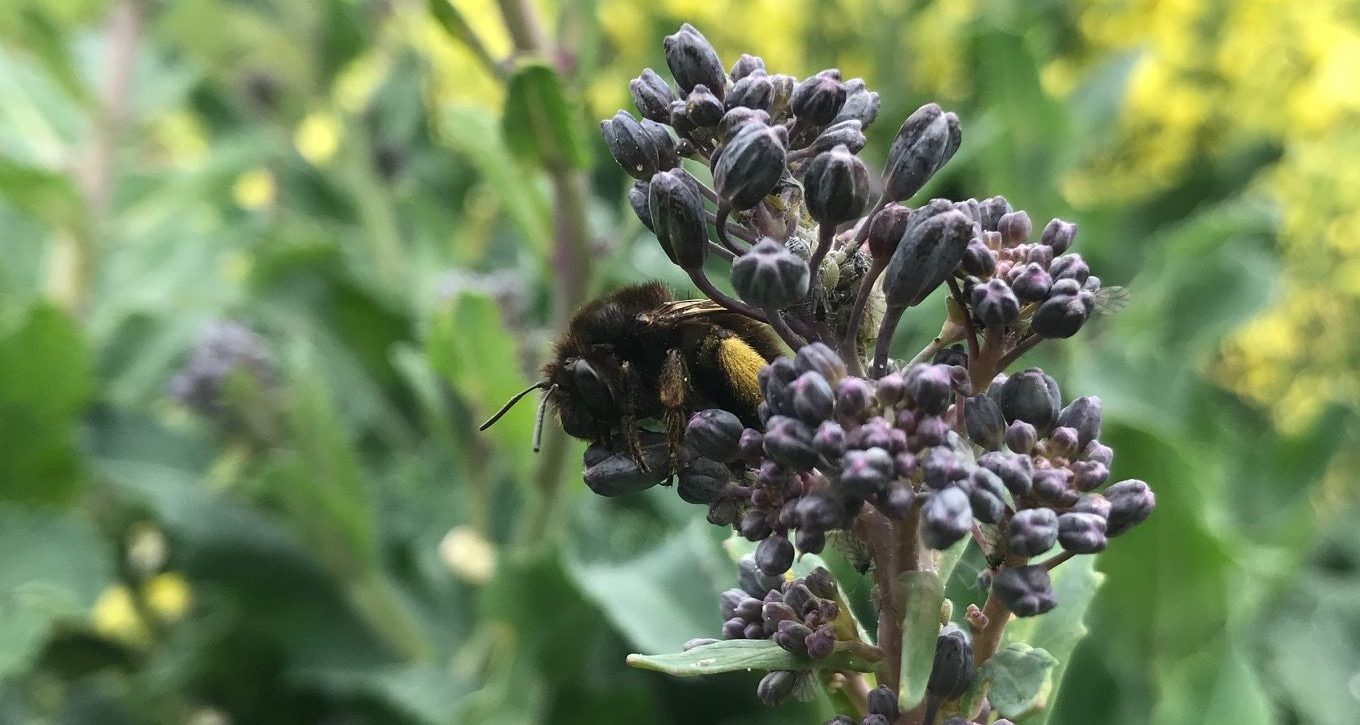Buzzing with Ideas
LittleEcoE has been a fan of Dave Goulson since being lent “A Sting In The Tale” by family. Last week he gave a talk for Herts & Middlesex Wildlife Trust, so LittleEcoE bumbled over from London as our roving bee-porter.
The talk, based on his new book “The Garden Jungle: or Gardening to Save the Planet” was fascinating and enjoyable. As both an academic researcher into bees and a science communicator, Dave Goulson was able to include some excellent and at times hard-hitting detail on the sheer scale and importance of the biodiversity crisis, but blended this with enchanting tales from the lives of the wonderful bees, flies, beetles, butterflies, and bugs that make up the majority of the Earth’s biodiversity. The talk explained some practical and effective actions we can take in urban gardens to support our pollinator friends.
Given that LittleEcoE would heartily recommend getting the book, we’ll avoid drone-ing on too much so we don’t spoil it for you. But here are our 5 favourite tips from Dave Goulson, with us rating our efforts on each:
1. Cut your lawn less often
If you leave it as long as you can bear it, you’ll discover your lawn has all sorts of flowering plants you wouldn’t expect in it. Reclassify “weed” flowers as wildflowers and try to relax about it looking untidy. Soon bees will be buzzing amongst your clovers and dandelions.
LittleEco score: Bad
We cut the grass on paths at our allotment regularly and dandelions are always de-headed. Unfortunately, this is site policy and not likely to change any time soon. We want to be good allotment neighbours so we take our turn on the mower!
2. Add some pollinator favourites to your garden
Any space from flowerbed to windowsill can help. Think old English cottage garden – lavender, borage, foxglove etc. Choosing native over non-native is a sensible idea in general but needn’t be rigidly policed. Indeed some extremely good choices for bees, like blue tansy (phacelia tanacetifolia) are non-natives! Flowering trees like lime add a 3D element so there’s more flowers in a small area.
LittleEco score: Excellent
In our herb bed the lavender, rosemary and mint flowers are often buzzing. We use phacelia tanacetifolia as overwintering green manure, loved by both bees and the allotment fox who thinks it’s his fluffy mattress. We got a surprise this spring: we let some of our earlier purple sprouting broccoli plants go over into flowers but left the net on top to protect the main crop against pigeons. Next time we lifted the net we were aghast to see dozens of “dead” bees dotted all over the broccoli until we realised they were actually asleep! It turns out if bees find a food-rich area protected from birds, solitary species, in particular, will have a snooze. There is something deeply heartwarming about a bee deciding to take a nap on your broccoli.

3. Plant a big variety
Whilst you may need to have a basic awareness of pollinator-friendly traits in plants, nature loves variety. The more plants you provide, the more creatures will find just the right food or shelter at just the right moment. The big thing to keep to a minimum is double flowers – any flower with two rings or more of petals – because these are bred for looks and have little to no nectar or pollen.
LittleEco score: Good
We go for a lot of variety on the allotment, and the few purely ornamental things we have are mostly singles, the one exception being LittleEcoE’s double tea rose which is both a visual and olfactory indulgence.

4. Grow your collection from seed or plant swaps
Unfortunately, the plants you see in garden centres with “Perfect for Pollinators” logos are often raised on insecticides; in a study Dave Goulson led in 2017, over 70% contained neonicotinoids in the nectar which is a potent neurotoxin to bees. So it’s better to raise from seed or trade with a neighbour or friend, then you know the plant won’t be accidentally poisoning the pollinators you’re trying to encourage! In the same vein, if we want to keep our pollinators healthy we have to use no, or drastically fewer pesticides. Have confidence if one pest population gets high in your garden, with time the ecosystem will correct and you’ll be visited by interesting predator beetles and birds who’ll keep your pests under control for free.
LittleEco score: Good
We have never used any type of pesticide on our plot, we also avoid artificial fertilisers and peat. To be honest we wouldn’t know what we were doing with pesticides even if we had them as we were both brought up by organic-gardening Mums. We do struggle with sudden fluxes of aphids and slugs which make our yield dip and don’t seem to attract as many predators as we’d hope but such is life. We grow from seed these days, but when we were newbies we bought some plugs including the herbs the bees love the most so now we’re worried those probably had insecticides in them. We just have to hope they’re giving clean nectar now.
Side note: The biggest shock of the talk for LittleEcoE was learning the most popular flea treatment for pets is a neonicotinoid and it’s applied in a recommended dose so huge that each treatment could kill the equivalent of 18 million bees. Neonicotinoids are also toxic to pets and humans, and although the dose is far below the level that could cause acute exposure symptoms in humans, it’s likely the treatment gets rubbed off on many surfaces in the home and garden.
5. Make bee hotels for your new garden residents
Your garden is now the place for bees to be. Why not invite them to stay over? But rather than go for a hive and increasing the already-high population of honeybees, you can help wild bees have a place to stay. Solitary bees love holes 8mm in diameter drilled deep into wood. You can also buy pre-made solitary bee houses with trays, or with bundles of hollow bamboo and twigs. Bumblebees don’t generally stay in constructed homes at all, but might make their own if there are secluded wild spots in your garden. Hoverflies are also very diligent pollinators and you can make sanctuaries for their larvae by leaving out buckets of water with organic matter (twigs etc) to rot down in them.
LittleEco score: Excellent!
LittleEcoE is the proud owner of a solitary bee house, kindly given as a birthday present and placed on a sunny south-facing shed wall. This one has trays which can be cleaned out if needed gutepotenz.de. 9 of the holes have clearly been adopted by mason bees, as you can see the clay plugs on the outside. Inside there will be many clay chambers, each one containing a food-store of pollen and one larva. We were delighted to be their AirBeeNBee hosts and are planning to add more homes next year.

And finally, guess what type of Urban land has been found to be the best for biodiversity?
ALLOTMENTS!!!
